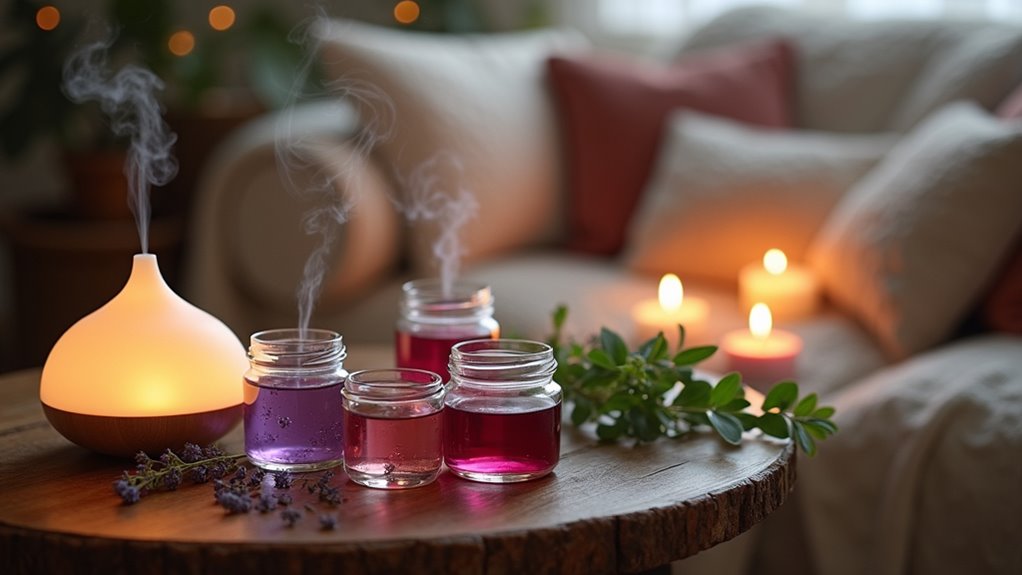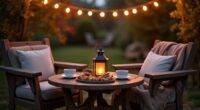Creating your own aromatherapy blends can be a simple yet effective way to set a romantic mood at home. By carefully selecting the right essential oils and combining them thoughtfully, you can craft personalized scents that enhance intimacy and relaxation. But knowing which oils work best together and how to use them effectively can make all the difference. Ready to discover how to create your perfect, sensual atmosphere?
Key Takeaways
- Select romantic essential oils like rose, jasmine, ylang-ylang, or sandalwood to evoke passion and intimacy.
- Use a base carrier oil and add a few drops of floral and warm aroma oils for a personalized blend.
- Incorporate diffuser or spray techniques to evenly distribute scent and create a cozy, romantic atmosphere.
- Enhance the mood with candle lighting, floral arrangements, and soft, flickering illumination.
- Store blends in dark glass bottles, keep in cool, dark places, and properly dilute for safety and longevity.
Selecting the Perfect Essential Oils for Romance
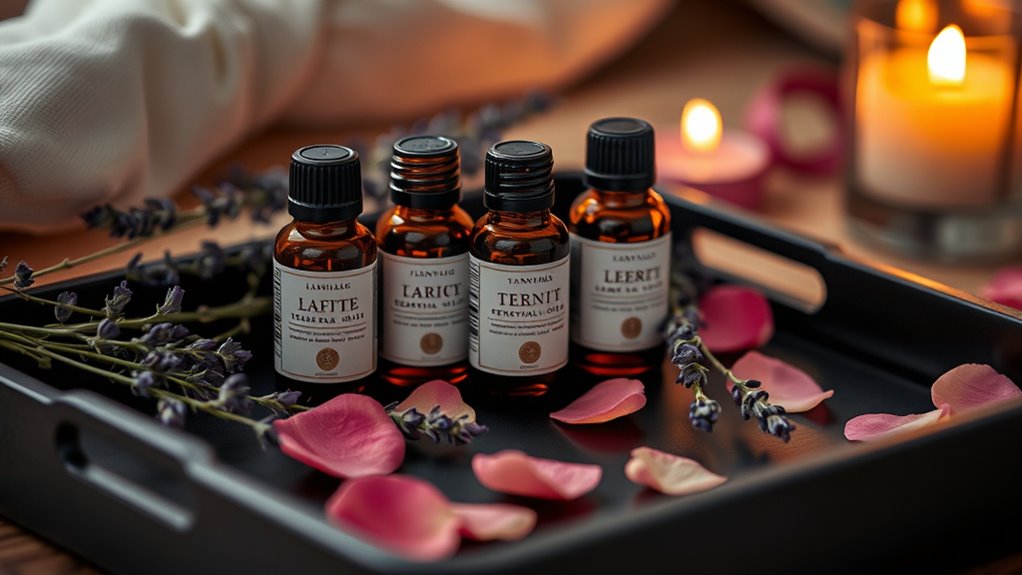
When choosing essential oils for romance, it’s important to focus on scents that evoke feelings of intimacy and passion. Flower symbolism plays a key role, as many blooms represent love and desire—think roses and jasmine. These oils are typically obtained through essential oil extraction, which preserves their natural aroma and therapeutic properties. When selecting oils, consider how their flower symbolism aligns with your romantic goals. For example, rose oil, derived via steam distillation from rose petals, is classic for love, while jasmine’s rich scent, extracted through solvent or steam methods, enhances passion. Understanding the extraction process helps guarantee you choose pure, high-quality oils that effectively evoke romance. With the right flower-inspired oils, you can craft an aroma that sets the perfect mood.
Crafting Your Custom Romantic Aromatherapy Blend
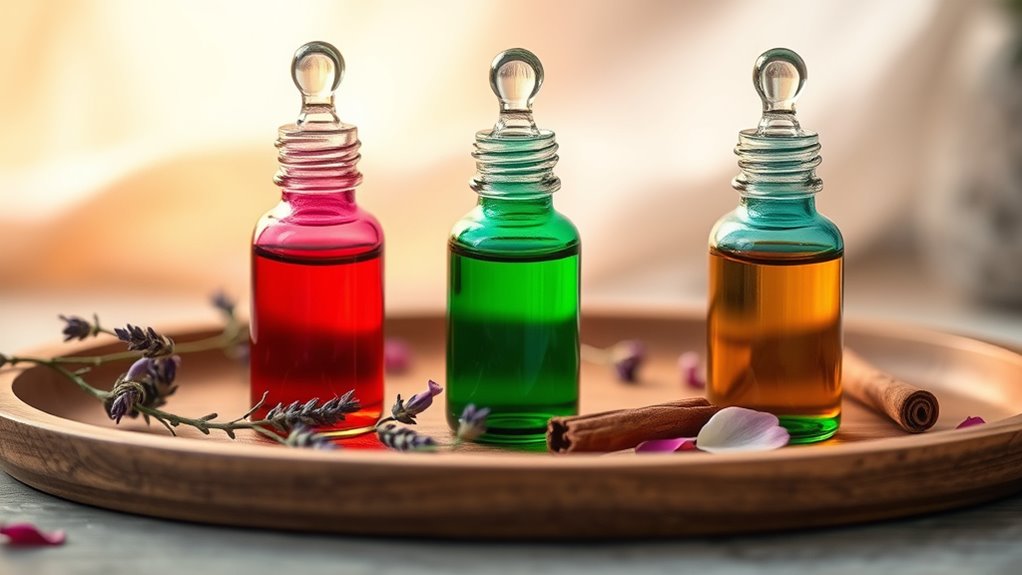
Creating your own romantic aromatherapy blend allows you to tailor the scent to evoke specific feelings of love and intimacy. Focus on flower symbolism to select oils that represent passion and affection—roses symbolize love, while jasmine suggests sensuality. Incorporate oils with aphrodisiac properties, such as ylang-ylang or sandalwood, to naturally boost desire. Start by choosing a base oil, then add a few drops of your selected essential oils, balancing floral and warm notes. Remember, blending is personal, so trust your senses and adjust accordingly. The goal is to craft a scent that resonates with your unique romantic vibe, enhancing your connection and making your intimate moments more memorable. Your custom blend becomes a fragrant reflection of your love story.
Tips for Enhancing the Atmosphere With Your Blends

To effectively enhance your environment with your aromatherapy blends, consider how the scent interacts with the space and mood you want to create. Incorporate gentle candle lighting to add warmth and intimacy, complementing your chosen aromas. During flower arranging, select blooms with subtle fragrances that harmonize with your blend, creating a cohesive sensory experience. Position candles strategically to highlight your floral centerpiece and encourage a calming atmosphere. Keep the lighting soft and flickering to evoke romance and relaxation. Adjust the placement of your aromatherapy diffusers or sprays to fill the room evenly, avoiding overpowering scents. Additionally, consider the home organization of your space to ensure the area remains clutter-free and inviting, enhancing the overall atmosphere. By thoughtfully combining candle lighting, flower arrangements, and scent, you set a romantic tone that’s both inviting and soothing.
Creative Ways to Use Your Aromatherapy Mixtures

Aromatherapy mixtures offer a versatile way to enhance your daily routines and spaces. You can explore their creative uses beyond diffusers, inspired by aromatherapy history and essential oil extraction techniques. For example, add a few drops to your bath for relaxation, or create a personalized massage oil blend. Use your mixtures to refresh linens or pillowcases, fostering intimacy and comfort. You can also incorporate them into homemade candles, combining art and scent. Understanding fragrance oils can help you craft more personalized and effective blends.
Safety Tips and Storage for Your Homemade Scents
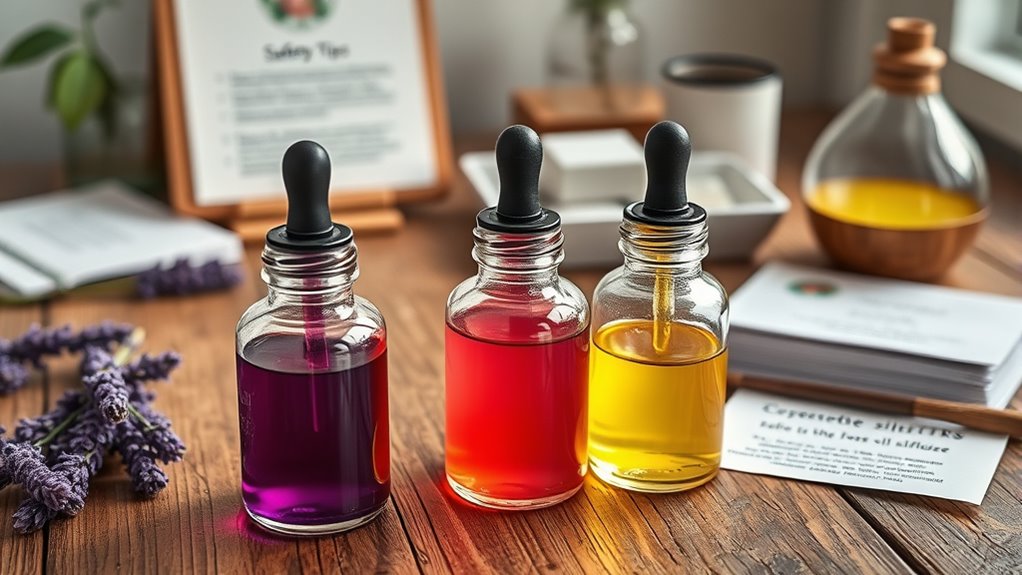
Keeping your homemade aromatherapy blends safe and well-preserved guarantees they remain effective and enjoyable. Always remember to dilute essential oils properly to prevent skin irritation and ensure safety. Essential oil dilution involves mixing concentrated oils with a carrier oil, like jojoba or almond, before storage or use. When it comes to storage container options, choose dark glass bottles to protect your blends from light exposure, which can degrade their quality. Store your blends in a cool, dark place away from heat and direct sunlight. Label each container clearly with the ingredients and date made. Proper storage and careful dilution help extend the shelf life of your scents, maintaining their aroma and therapeutic benefits while keeping you safe during use.
Frequently Asked Questions
Can I Mix Essential Oils With Carrier Oils for Personal Application?
Yes, you can mix essential oils with carrier oils for personal application. Just follow dilution guidelines to guarantee safety and avoid skin irritation. Use proper blending techniques, such as adding drops of essential oil to a carrier oil like jojoba or coconut, then mix thoroughly. Typically, a 1-3% dilution is recommended for topical use. Always do a patch test first to check for sensitivities before applying broader.
How Long Do Homemade Aromatherapy Blends Typically Last?
Imagine you create a romantic lavender and ylang-ylang blend; it typically stays fresh for 6 to 12 months with proper storage. Your shelf life depends on ingredients and storage tips—keep blends in dark, airtight containers away from sunlight and heat. Over time, essential oils may lose potency or develop a scent change, so it’s best to use your homemade aromatherapy within this period for ideal effects.
Are There Any Essential Oils to Avoid During Pregnancy?
During pregnancy safety, you should be cautious with essential oil restrictions. Some essential oils are not safe during pregnancy because they may cause contractions or other issues. It’s best to avoid oils like rosemary, basil, and clary sage. Always check with a healthcare provider before using any essential oils, especially if you’re pregnant. This way, you protect yourself and your baby from potential risks associated with certain essential oils.
What’S the Best Way to Diffuse Blends in a Small Space?
To diffuse blends effectively in a small space, start with proper diffuser placement—position it away from direct airflow and in a central spot. Use scent layering to create a cozy ambiance by combining complementary oils at low concentrations. Keep the diffuser running for short periods, around 15-30 minutes, and adjust as needed. This approach guarantees the aroma is pleasant without overwhelming, creating an inviting, romantic atmosphere.
How Do I Know if I Have an Allergic Reaction to a Blend?
It’s funny how a whiff of a new scent can suddenly make you sneeze or itch—that’s a sign you might have an allergy. When using essential oils, always prioritize safety; start with a patch test and watch for allergy symptoms like skin irritation or breathing issues. If anything feels off, stop using the blend immediately. Knowing essential oil safety helps you enjoy aromatherapy without risking an allergic reaction.
Conclusion
Your handcrafted blend is like a secret garden, where each scent blooms to nurture intimacy. As you infuse your space with these aromatic whispers, you’re planting seeds of connection that grow into lasting bonds. Remember, the true magic lies in your intention and care—transforming simple ingredients into a symphony of love. With each carefully chosen note, you’re cultivating an atmosphere where passion and tenderness can flourish, turning everyday moments into timeless memories.
